System Restore Points are states of Windows OS that can be used to fix the computer if anything goes wrong, right from missing system files to unstable unsigned drivers. That said, all Restore Points are saved into the drive for which it is created, and are limited by space. It is obvious that you may not be able to keep a lot of copies because of limited primary storage.
If any of the Restore Points goes corrupt and Windows is not able to recover, then it’s a problem that is difficult to sort. In this post, we will take a look at whether it is possible to backup restore points or recover corrupt restore points in Windows 11/10.
Can you backup Restore points in Windows 11/10?
Backing up Restore Points in Windows 11/10 is like taking a backup of a backup. While it used to work in Windows 7 and Windows XP, it doesn’t seem to work in Windows 11/10. So what I did, I tried giving both Read-only and Full access to an admin account and check if it worked. Here are my experiences and clarity on the topic.
Open File Explorer and then open Primary Drive, i.e., on which Windows is installed. In the File Explorer menu on the top, switch to View tab > Options > View.
Locate the option that says — Hide protected operating system files. Uncheck, and apply the change.
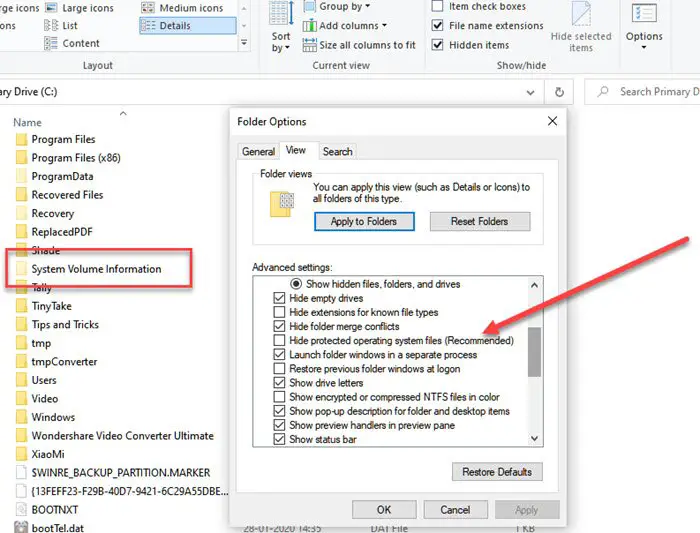
In the Primary Drive, locate a folder with the name System Volume Information. If you try to access it, the System will deny access. The regular users, including admins, don’t have access to it. However, it is possible to add some level of permission, even if Read-only, to allow you access to the folder to copy the restore points.
Right-click on the System Volume Information folder and click on Properties from the fly-out menu.
Switch to the Security Tab and then on the Advanced button to open Advanced Security Settings. Next, click on the Add button > Select a principal link > Advanced button > and then the Find Now button.
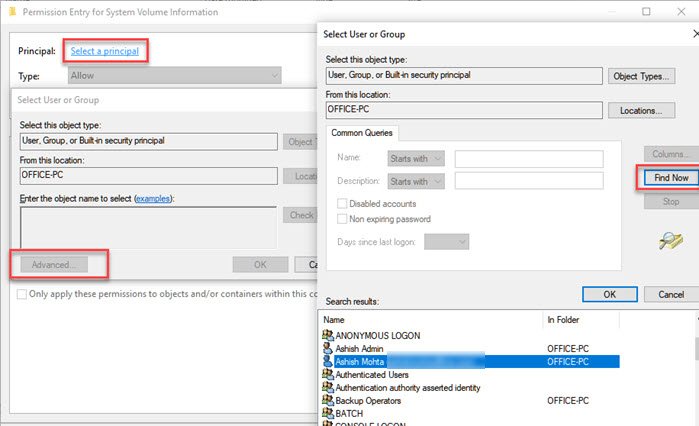
It will list down all the users available on the list. Find your account, and then select the user you need to add. Click on the OK button, and it will be added to the User or Group box. Click on the OK button again.
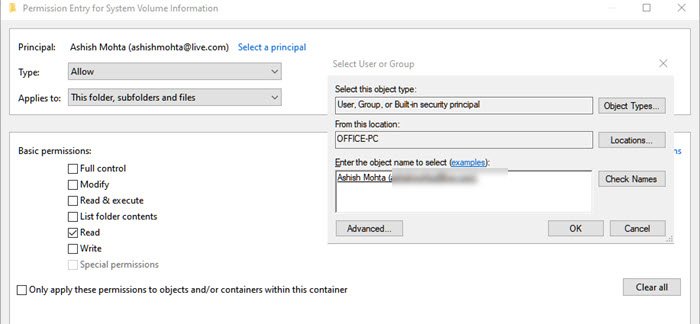
Back to the Permission Entry box – here you can now choose what permission should be made available. Uncheck everything except for “Read” permission.
That is where everything changes because while we assume that the user has full information, and will be able to copy the restore file and use it somewhere else, it doesn’t work that way.
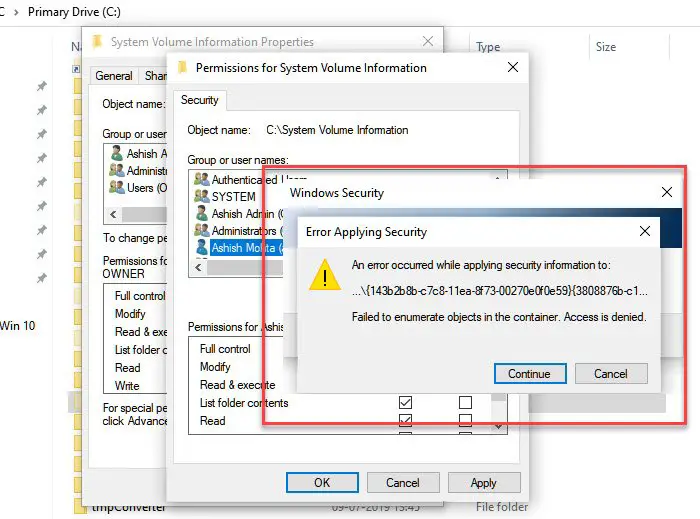
In the above method, When you try to apply for permission, you will face issues that access to specific files, even if it is only READ, is not given to the Current User.
Also if you try the same with the hidden Administrator account, the access is not granted. The only thing that seems to work is that you can access the folder and view the files inside it, but nothing else.
When I tried to copy one of the restore files, it did not allow me as I did not have the permission, what it seems, that the files are only available for the OS to manage.
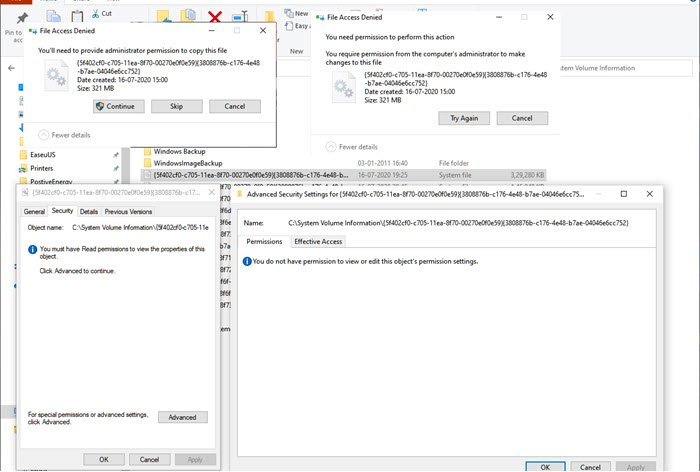
At least as of now, I don’t see any way to back up Restore points.
Read: What happens if you interrupt System Restore?
Can you Recover corrupt System Restore Points?
Many a time System Restore Points don’t work as expected, and when you try to restore, you may get errors. That may look like the System Restore Point has become corrupted. That said, if the physical files where System Restore is saved are damaged, then you cannot restore them at all. However, if it is because of Volume Shadow Copy or third-party service interference, then it can be resolved.
While we cannot say that this will help, if you are faced with corrupt system restore points, following the given order would be your best bet.
1] Run System File Checker
The System File Checker (sfc.exe) is a system utility to scan for and restore corrupt Windows system files. While we have explained this in detail in our post on how to Run System File Checker, all you need to do is run the below-mentioned command on the Command Prompt (using admin privileges):
sfc /scannow
2] Set Volume Shadow Copy Service to Automatic
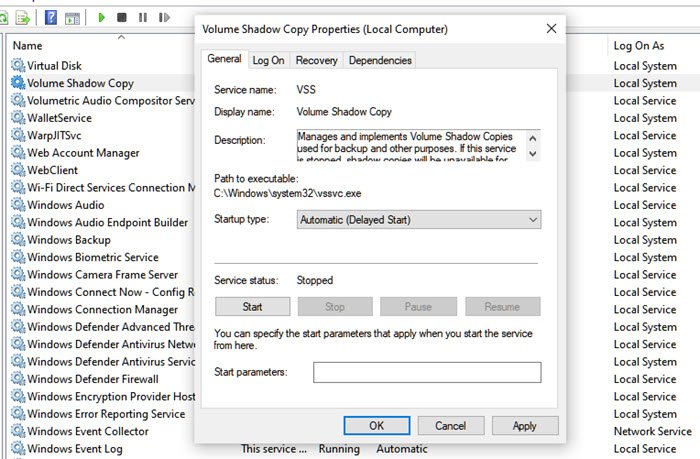
The Volume Shadow Copy service in Windows is relevant to disk imaging. The service is used to restore your computer – a complete drive or a folder – to some previous state. If it is turned off, you may not be able to restore the System. Follow the steps to set out to automatic.
- Type Services.msc in the Start Menu search box and press Enter when it appears in the list.
- Locate the service Volume Shadow Copy Service and set it to Automatic.
- Click on the Start button or restart your computer to get it started.
3] Disable Third-Party Interference
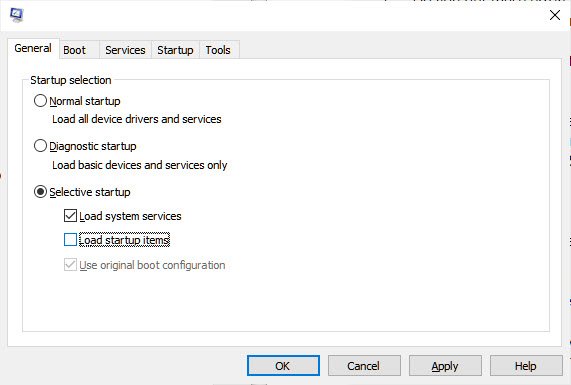
- Type msconfig in the Run prompt (Win + R) and press the Enter key
- In the Configuration window, switch to the General tab
- Click to clear the Load startup items checkbox.
- On the Services tab, click to select the Hide all Microsoft services checkbox, and then click Disable all.
- Click OK, and then click Restart.
Now try restoring the system and check if it works.
Lastly, if nothing else works, try restoring to a different date if you have multiple restore points available.
I hope this helps!
Read: What should be the frequency of System Restore Points in Windows?
How do I recover system restore points?
If a system restore point is corrupted and you need to recover your system, boot your PC into Safe Mode and attempt to use System Restore again. You can perform manual backup restoration if you have a system image backup or another type of backup. This involves booting from a recovery drive or installation media and selecting the backup version you want to restore. If you have more restore points available, try reverting your system to a previous state. Regularly update and verify your backups to ensure they’re functional when needed.
Can I copy a restore point?
Restore points are stored as part of the system volume information and are closely linked to the system’s configuration and state. They are not meant to be copied or transferred to another system. That said, while you cannot directly copy a restore point in Windows 11/10, you might consider other backup methods, such as System Image Backup or File Backup if you want to save and possibly move a specific state of your system to another system.
Read Next: The restore point could not be created for the following reason.
Leave a Reply